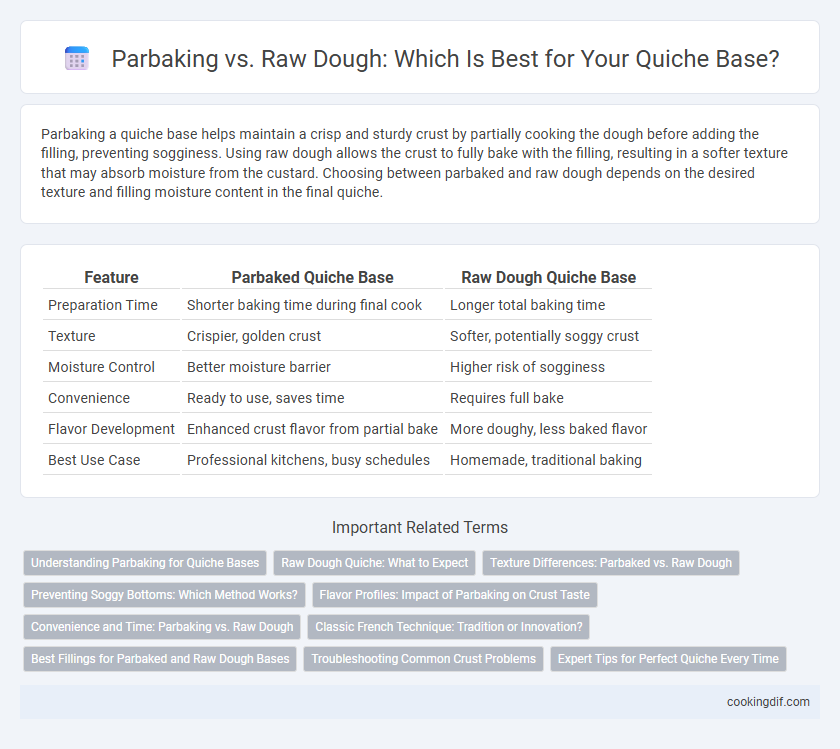Parbaking a quiche base helps maintain a crisp and sturdy crust by partially cooking the dough before adding the filling, preventing sogginess. Using raw dough allows the crust to fully bake with the filling, resulting in a softer texture that may absorb moisture from the custard. Choosing between parbaked and raw dough depends on the desired texture and filling moisture content in the final quiche.
Table of Comparison
| Feature | Parbaked Quiche Base | Raw Dough Quiche Base |
|---|---|---|
| Preparation Time | Shorter baking time during final cook | Longer total baking time |
| Texture | Crispier, golden crust | Softer, potentially soggy crust |
| Moisture Control | Better moisture barrier | Higher risk of sogginess |
| Convenience | Ready to use, saves time | Requires full bake |
| Flavor Development | Enhanced crust flavor from partial bake | More doughy, less baked flavor |
| Best Use Case | Professional kitchens, busy schedules | Homemade, traditional baking |
Understanding Parbaking for Quiche Bases
Parbaking quiche bases involves partially baking the crust before adding the filling, which prevents sogginess and ensures a crisp, golden texture. This technique is particularly effective for custard-rich quiches where the filling requires longer baking times, as it maintains the structural integrity of the crust. Using raw dough can lead to a soggy bottom, especially with wet fillings, making parbaking a preferred method for achieving a perfectly cooked quiche base.
Raw Dough Quiche: What to Expect
Raw dough quiche requires a longer baking time to ensure the crust is fully cooked and crisp, preventing a soggy bottom. Expect the edges to develop a golden-brown color while the filling sets evenly, delivering a rich, custard-like texture. Properly blind baking the raw dough for a few minutes before adding the filling can enhance structural integrity and reduce moisture absorption.
Texture Differences: Parbaked vs. Raw Dough
Parbaking a quiche base creates a firmer, crispier crust that maintains structure and prevents sogginess from the moist filling. Raw dough yields a softer, more tender crust that absorbs more moisture, resulting in a less crunchy texture but a richer, buttery bite. Choosing parbaked crusts enhances textural contrast, while raw dough emphasizes a delicate, cohesive mouthfeel in the finished quiche.
Preventing Soggy Bottoms: Which Method Works?
Parbaking the quiche base partially cooks the crust, creating a firm barrier that prevents moisture from the filling from soaking in, effectively avoiding soggy bottoms. Using raw dough directly can often result in a wet, underbaked crust due to the filling's high moisture content. Parbaking at 375degF for 10-15 minutes is the preferred method for achieving a crisp, perfectly textured quiche base.
Flavor Profiles: Impact of Parbaking on Crust Taste
Parbaking a quiche crust partially cooks the dough, creating a crispier texture and a nuttier, toasted flavor that enhances the overall taste experience. Raw dough often yields a softer, chewier crust with less depth in flavor, allowing the filling to dominate. The Maillard reaction during parbaking intensifies the crust's aroma and adds complexity, balancing the rich, creamy quiche filling.
Convenience and Time: Parbaking vs. Raw Dough
Parbaking a quiche base offers significant convenience by reducing overall baking time and minimizing the risk of a soggy crust, as the crust partially cooks before adding the filling. Using raw dough requires longer baking times and careful monitoring to ensure the crust is fully cooked and crisp without overbaking the filling. Parbaked crusts enable faster meal preparation, making them ideal for busy cooks seeking consistent results.
Classic French Technique: Tradition or Innovation?
Parbaking the quiche base ensures a crisp, well-structured crust that holds up to the moist filling, reflecting the classic French technique's emphasis on texture and precision. Raw dough offers more flexibility for home cooks but risks sogginess, deviating from traditional pate brisee methods used in authentic quiches. The debate highlights the balance between preserving French culinary tradition and embracing modern kitchen efficiency.
Best Fillings for Parbaked and Raw Dough Bases
Parbaked quiche bases maintain crispness, making them ideal for custard-heavy or vegetable-rich fillings like spinach and mushroom, as the partially cooked crust prevents sogginess. Raw dough bases absorb moisture from wet fillings such as bacon and cheese or quiche Lorraine, creating a softer, integrated texture when fully baked. Choosing the right base depends on the moisture content and texture of the filling to ensure optimal quiche consistency and flavor.
Troubleshooting Common Crust Problems
Parbaking quiche crust prevents sogginess by ensuring a fully cooked and crisp base before adding the filling, reducing issues like undercooked or soggy bottoms. Using raw dough can lead to uneven baking, where the crust edges may burn while the center remains doughy due to moisture release from the filling. To troubleshoot common crust problems, parbake at 375degF (190degC) for 10-15 minutes with pie weights to maintain shape and achieve a consistently crisp texture.
Expert Tips for Perfect Quiche Every Time
Parbaking quiche crust creates a sturdy, flaky base that prevents sogginess by sealing moisture from the filling, while using raw dough allows for a softer, more tender texture that absorbs flavors. Experts recommend parbaking at 375degF for 10-15 minutes with pie weights to ensure an even, golden crust before adding custard and fillings. Choosing between parbaked and raw dough depends on your preference for texture and the moisture content of the filling, with parbaking offering a foolproof method for consistently crisp results.
Parbaking vs raw dough for quiche base Infographic

 cookingdif.com
cookingdif.com